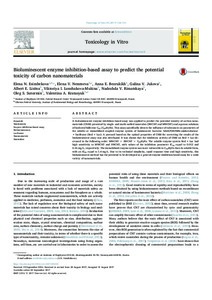Bioluminescent enzyme inhibition-based assay to predict the potential toxicity of carbon nanomaterials
Скачать файл:
URI (для ссылок/цитирований):
https://www.sciencedirect.com/science/article/pii/S0887233317302527?via%3Dihubhttps://elib.sfu-kras.ru/handle/2311/111254
Автор:
Есимбекова, Е. Н.
Немцева, Е. В.
Безруких, А. Е.
Жукова, Г. В.
Лисица, А. Е.
Лоншакова-Мукина, В. И.
Римацкая, Н. В.
Сутормин, О. С.
Кратасюк, В. А.
Коллективный автор:
Институт фундаментальной биологии и биотехнологии
Кафедра биофизики
Дата:
2017Журнал:
Toxicology in VitroКвартиль журнала в Scopus:
Q1Квартиль журнала в Web of Science:
Q2Библиографическое описание:
Есимбекова, Е. Н. Bioluminescent enzyme inhibition-based assay to predict the potential toxicity of carbon nanomaterials [Текст] / Е. Н. Есимбекова, Е. В. Немцева, А. Е. Безруких, Г. В. Жукова, А. Е. Лисица, В. И. Лоншакова-Мукина, Н. В. Римацкая, О. С. Сутормин, В. А. Кратасюк // Toxicology in Vitro. — 2017. — Т. 45. — С. 128-133Текст статьи не публикуется в открытом доступе в соответствии с политикой журнала.
Аннотация:
A bioluminescent enzyme inhibition-based assay was applied to predict the potential toxicity of carbon nanomaterials (CNM) presented by single- and multi-walled nanotubes (SWCNT and MWCNT) and aqueous solutions of hydrated fullerene С60 (C60HyFn). This assay specifically detects the influence of substances on parameters of the soluble or immobilised coupled enzyme system of luminescent bacteria: NAD(P)Н:FMN-oxidoreductase + luciferase (Red +Luc). A protocol based on the optical properties of CNM for correcting the results of the bioluminescent assay was also developed. It was shown that the inhibitory activity of CNM on Red +Luc decreased in the following order: MWCNT > SWCNT > C60HyFn. The soluble enzyme system Red + Luc had high sensitivity to MWCNT and SWCNT, with values of the inhibition parameter IC50 equal to 0.012 and 0.16 mg/L, respectively. The immobilised enzyme system was more vulnerable to C60HyFn than its soluble form, with an IC50 equal to 1.4 mg/L. Due to its technical simplicity, rapid response time and high sensitivity, this bioluminescent method has the potential to be developed as a general enzyme inhibition-based assay for a wide variety of nanomaterials.

